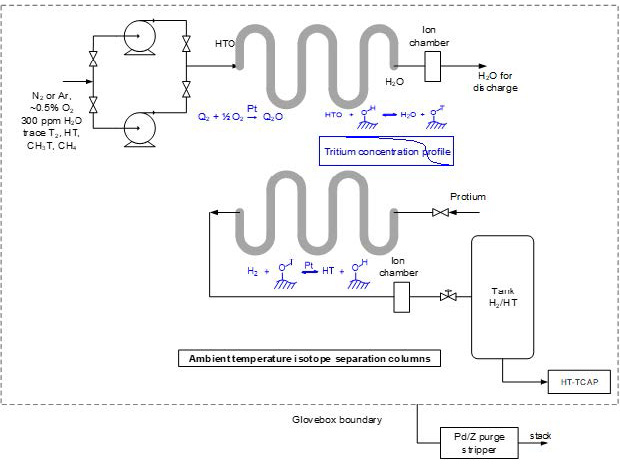Tech Briefs
Savannah River National Laboratory
Glovebox Tritium Gas Cleanup
Technology Overview
Savannah River National Laboratory (SRNL) has developed a much-simplified, but potentially more efficient process using an isotope separation column for glovebox tritium gas cleanup. The SRS Tritium Facilities utilizes gloveboxes as secondary confinement for tritium processes, which allows any tritium released from primary confinement to be processed for cleanup. The isotope separation columns operate at ambient temperature and can potentially replace the functionality of multiple processes. Specifically, an oxidation catalyst bed and accompanying preheater and cooler, multiple ambient temperature zeolite beds, zeolite bed bake out operation and magnesium bed could be eliminated.

Benefits
- Simplicity with ambient temperature operation
- High efficiency with 1 million decontamination factor (DF) possible
- Total recovery, no second waste streams
- No heat load inside glovebox
Applications and Industries
- This technology has the application potential in the Savannah River Tritium Enterprise (SRTE), other tritium facilities, nuclear and fusion development.
Description
The technology is unique with its process configuration, column material, and chemistry, synchronized in a simple way to remove trace amounts of tritium, tritiated water, and tritiated hydrocarbons from glovebox atmospheres. It can be adapted within the existing footprint of the tritium glovebox system (refurbishment option) or in a new system design. The design provides an unequivocal advantage over existing processes, and is predicated on simplicity, reliability, cost of operation, and efficiency.
Intellectual Property
- US Patent 11,058,994, 2021, “Tritium cleanup system and method”, by Xin Xiao, Lucas M. Angelette, Paul R. Beaumont, Henry T. Sessions, Heather Mentzer, Jared L. Clark
Partnering Opportunities
SRNL invites interested companies with proven capabilities in this area of expertise to develop commercial applications for this process under a cooperative research and development agreement (CRADA) or licensing agreement. Interested companies will be requested to submit a business plan setting forth company qualifications, strategies, activities, and milestones for commercializing this invention. Qualifications should include past experience at bringing similar products to market, reason-able schedule for product launch, sufficient manufacturing capacity, established distribution networks, and evidence of sufficient financial resources for product development and launch.
Download Tech Brief
Contact Information
Savannah River National Laboratory
E-mail: partnerships@srnl.doe.gov